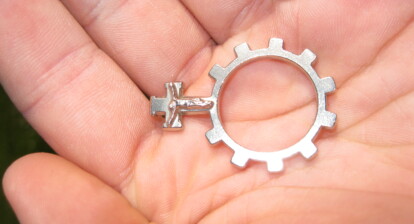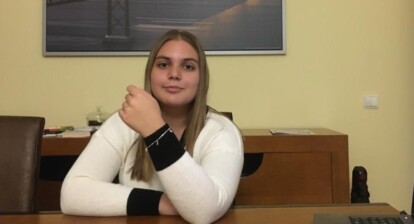Music begins where words end: For our author Rusudan from Georgia piano is more than just an instrument. As a carrier of family memories, as a European meeting point and gate to foreign traditions, it helped her to overcome crucial barriers – especially the invisible ones.
Have you ever had to attend different classes because your parents told you something like: “You will thank me later”? Well, I am here to tell you that in my case, parents were right! Little did I know that six years of reluctant practice would musically accompany my encounters with EUSTORY and the History Campus Blog, making my first experience abroad with the 2018’s “Next Generation Summit” stand out even more, thus picking up playing piano again – this time, with my own will.
Tune In For Weinbach
Many families or individuals own something that speaks more to them than ordinary words could. In my family’s case, it is the Weinbach fortepiano. Even though it was expensive, my grandparents wanted their children to play the piano so much that they had shipped it to Tbilisi in 1974. In the end, their wish came true one generation later.
I clearly remember the day when I touched the piano for the first time – not to childishly mess around but to actually play it. I was seven years old. Making a soulless piece of wood produce melody felt empowering. During my 6 years of studying at Art School, I slowly realised that music is much more than just an activity parents force their children to do. It is a spice of life. Every new piece intrigued me more than the one before. I was not reluctant to study anymore – I was eager instead. This processual perception shook my conscience not to waste time but learn something that would last a lifetime – like Georgian folklore, Slavic and Nordic dances and famous composers’ biographies, their works as well as all sorts of musical genres.
The Language Without Words
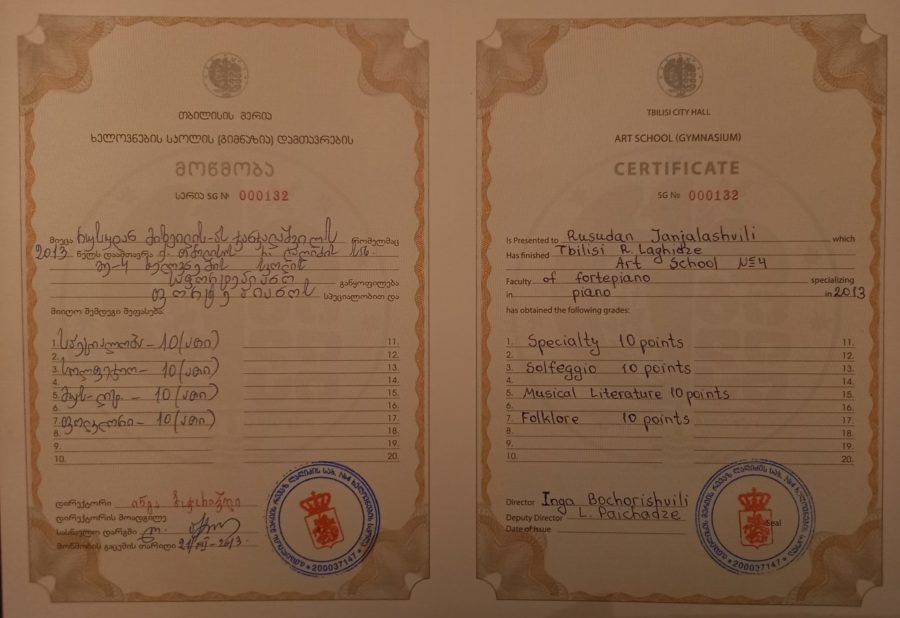
Certificate of successfully graduating from Art School (the faculty of pianoforte) in 2013 (Photo: Private).
This certificate might be just a piece of paper for an ordinary passer-by but for me, it awakes memories of the first time I touched the piano. For years, it took me several hours per day to achieve the level I reached for, to sound the way I wanted it to sound like. Quite often, I neither had enough time to study for school nor to go for other social activities. However, I decided to shorten my sleeping hours at night to play the piano. Listening to the pieces on the cassette player and discussing my interpretations with the teacher and other students, as well as going through the piles of old hand written notes felt like a dive into history. All this helped me to better express my emotions.
Even the tension I experienced before concerts seemed fun once I shared it with my friends – playing in empty air on the imaginary piano altogether backstage soothed our anxiety of walking up the stairs to the stage. Although this musical adventure required much perspiration, the excitement of learning something new was worth it. The certificate I received at Art School was the end of a journey that taught me a lot: communicating better, raising my awareness that music is the best ice-breaker one could ever imagine. It brings people together faster than any interesting dialogue would, simply because it’s an international language everyone understands and feels.
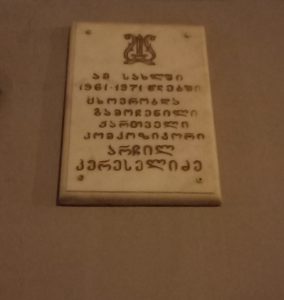
The commemorative plaque at the entrance of my house, implying the name of the Georgian composer Archil Kereselidze who lived here from 1961 to 1971 (Photo: Private).
In the meantime, I felt even more comfortable and right in the house I grew up – during the 1960’s, the Georgian composer Archil Kereselidze used to live right above my apartment for 10 years.
“The Game Is On!”
I would lie if I said playing the piano was in my everyday routine after graduation. However, one event changed it – in November 2018, I participated in the EUSTORY Next Generation Summit. This was a chance to meet people with various cultural backgrounds. I found the piano in the cozy corner of the dining hall to be the best freetime activity at the Summit to share with each other the tunes we grew up with.
For instance, Italian peers started singing their famous folk song, an anthem for partisans during World War II – “Bella Ciao” and all those who joined the spontaneous choir developed a strong feeling of togetherness which united us during the entire Summit. However, I was too shy to play the piano at first. Only after witnessing the atmosphere of uncertainty being melted by the sounds of the instrument did I manage to actually play it in front of the others. After a gap of one year, the company of participants from Finland and Germany motivated me to finally play again. I remember that I chose the soundtrack from the TV Series “Sherlock”, “The Game is on”, and this is how my musical history with EUSTORY began.
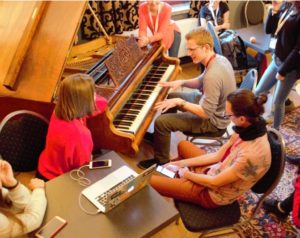
Making friends with music during free time at the EUSTORY Next Generation Summit 2018 (Photo: Körber-Stiftung).
At such a piano gathering, I was approached by a peer from Poland, asking “Will you dance Polka with me?”. One of the things I really regret is not having said “Yes” just because of my shyness, even though Polka was my favourite Slavic folk dance I learnt at Art School. The reason why I like this Czech couple dance the most is the simplicity and easiness behind it, implying that not everything has to be serious in life. Polka is known for its humorous, happy, repetitive and energetic motifs. In the 19th century, it became famous all over Europe and I can definitely see the reason for that: dancing cheerfully at social gatherings can be a true refreshment in everyday life.
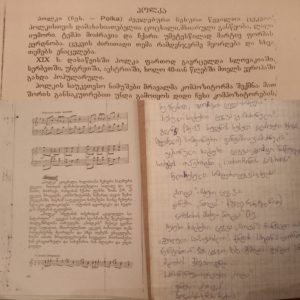
My notes in Georgian about Polka while studying the subject of Musical Literature (Photo: Private).
Reviving the Sound of Childhood
During the Summit, the piano was always a place to gather around – there, I had an encounter with a Bulgarian participant, Momchil, asking me if I knew how to play the traditional Finnish tune “Ievan Polkka”, playing a few notes to remind me of it – but I could not.
Exactly two years later, he contacted me with the same question via Instagram – my answer was still negative. So, appreciating his consistency, a few weeks later, I could! While learning it, I had my biggest “Eureka” of last year: A Finnish Polkka remix, called Holly Dolly “Dolly Song” was the tune which had been played on Georgian TV for years and which I had listened to my whole childhood. Have you ever experienced the combination of disappointment and anxiety because you forgot the name of your favorite song, not being able to find it again? I have never lifted a curse but I imagine finding it to cause the same feeling – true breath of relief.
Written in the old Finnish dialect, “Ievan Polkka” literally translates to “Ieva’s Polkka”. The story is told from the boy’s perspective, describing his eagerness to play and dance the night away with the girl he likes, called Ieva. She has strict parents but he still does not give up – the tale as old as time. What many don’t know is that unlike the tune, the lyrics themselves aren’t part of the folklore – it was written by the Finnish composer Eino Kettunen in 1928. As for the melody, it is said to date back to the 17th century.
The lightbulb in my head was switched on when I found out that the catchiest lyrics of this song – “Salivili hipput tupput täppyt Äppyt tipput hilijalleen”, like the whole chorus part, were actually gibberish – so this was why this part reminded me of boots tapping on the floor! I fell for this song even more when I imagined it being the source of amusement for generations in the past and for those to come. It was the tune the ancestors of my Finnish friends used to dance to, keeping themselves warm in the cold and snowy environment of Finland with this sweetly silly song.
Traces of Musical Traditions
When my next encounter with EUSTORY took place in Hamburg in February 2020 at the Editors’ Workshop, Neasa from Ireland turned on the music on her phone. Not being familiar with the Irish language, known as Gaeilge, at first it reminded me of the song I loved since I had watched “Outlander” , called “Gaol ise Gaol i” (literally translated as “She’s my Love”). Picturing the women waulking the cloth, I screamed out “Is that Gaelic?” and yes, it was. The song was in Scottish Gaelic, which is not the same as the Irish Gaeilge.
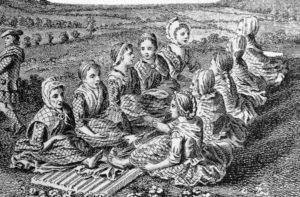
Scotswomen waulking cloth and singing the waulking song in Gaelic (Public Domain, https://en.wikipedia.org/wiki/File:Waulking_18th_century_engraving.jpg).
Actually, the song my Irish friend was listening to was “Siúil a Rún” (literal translation: “Walk, my Love!”) covered by an Australian singer with Celtic roots, Ella Roberts. This version of a traditional Irish song became my favorite one, simply because of my respect for the singer to embrace her roots. For me, the sound of bagpipes mixed with her nasalisation was mesmerising, telling the story of a woman lamenting over her lover who followed a military career. I had another “Eureka” then – the reason why I fell for these songs was not only the reflection of peoples’ customs, it was also another form of heritage: language.
Celtic Songs and Other Life Changers
Being interested in languages, I enjoyed looking for the same Georgian nasal sounds in other languages which foreigners generally find hard to pronounce. One such sound is “Kh”. In European languages, German “ch” is the most similar to it. After years, my search ended at the Editors’ Workshop when I found out more about the Scottish Gaelic and Irish Gaeilge. I was happy because I felt my view on the world had been widened a bit.
Music and EUSTORY encounters, both changed my life in different, but somehow similar ways, raising my knowledge about Europe and helping me to bring the sounds of my childhood alive. I gained new perspectives and lessons for life: do not refuse when someone asks you to dance Polka, don’t be too shy to sing traditional songs or play them on the piano – you will find out more about people from different cultural backgrounds, and about yourself.


